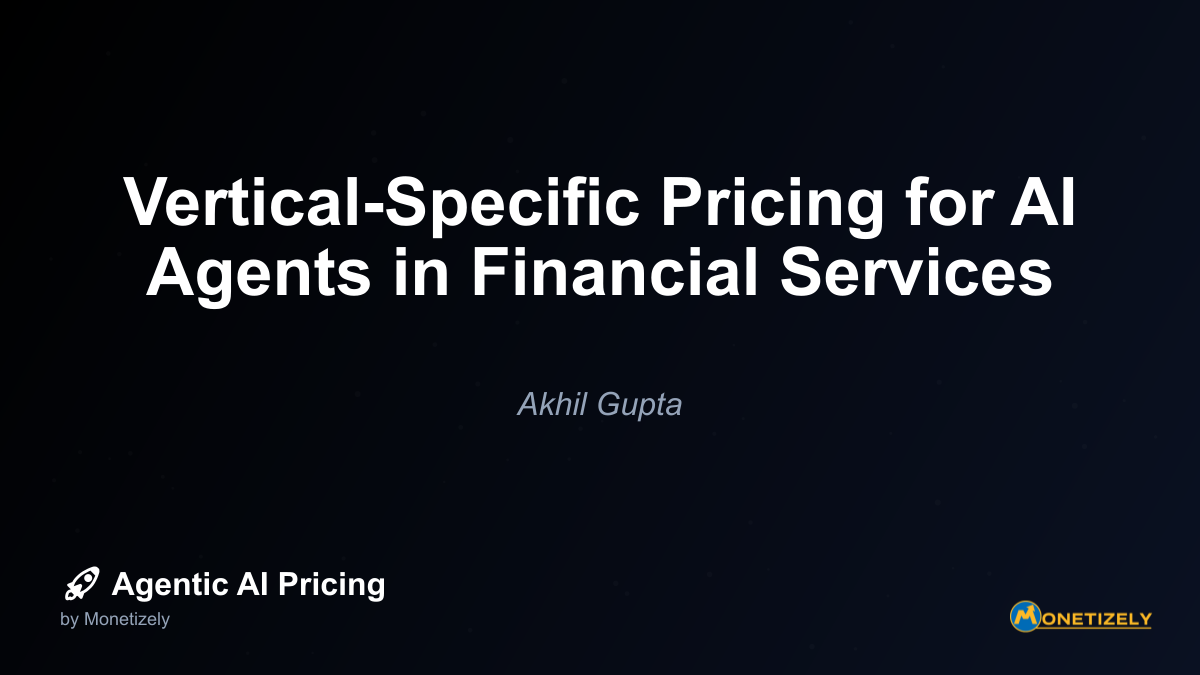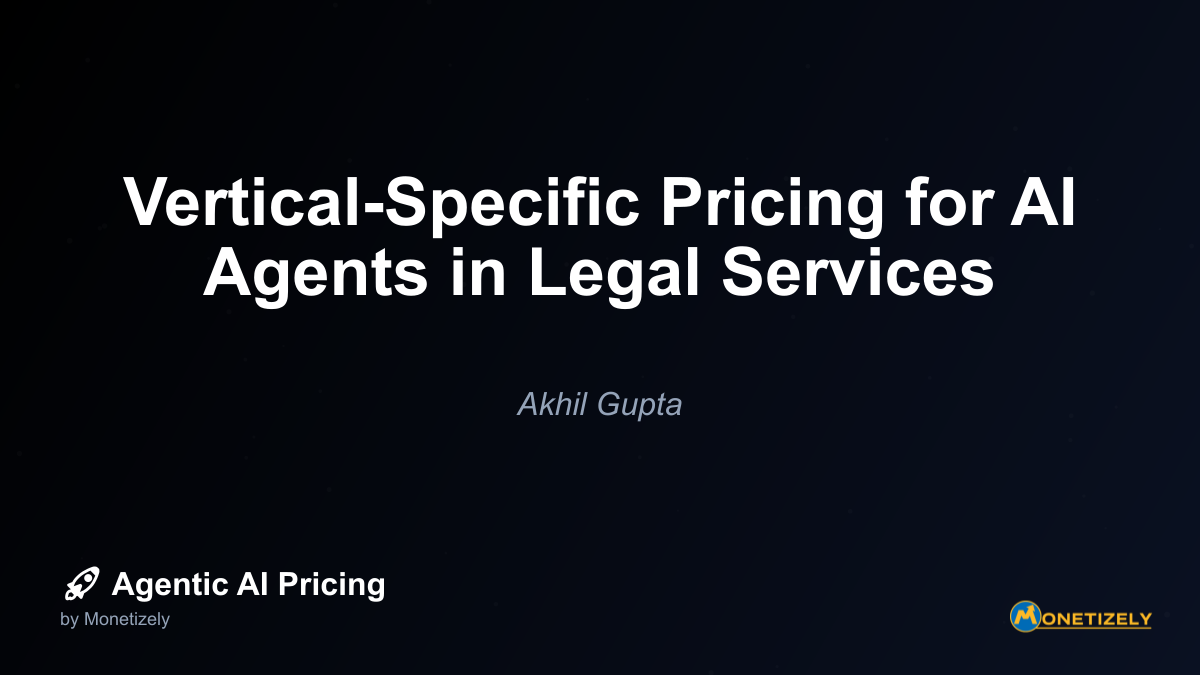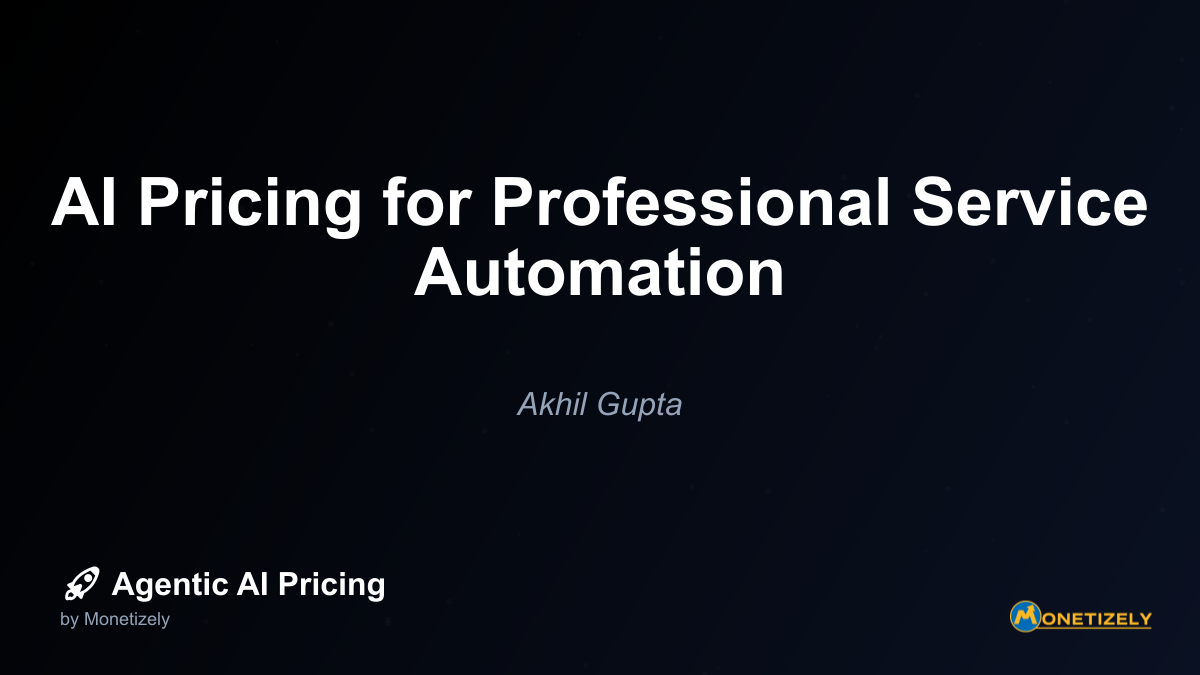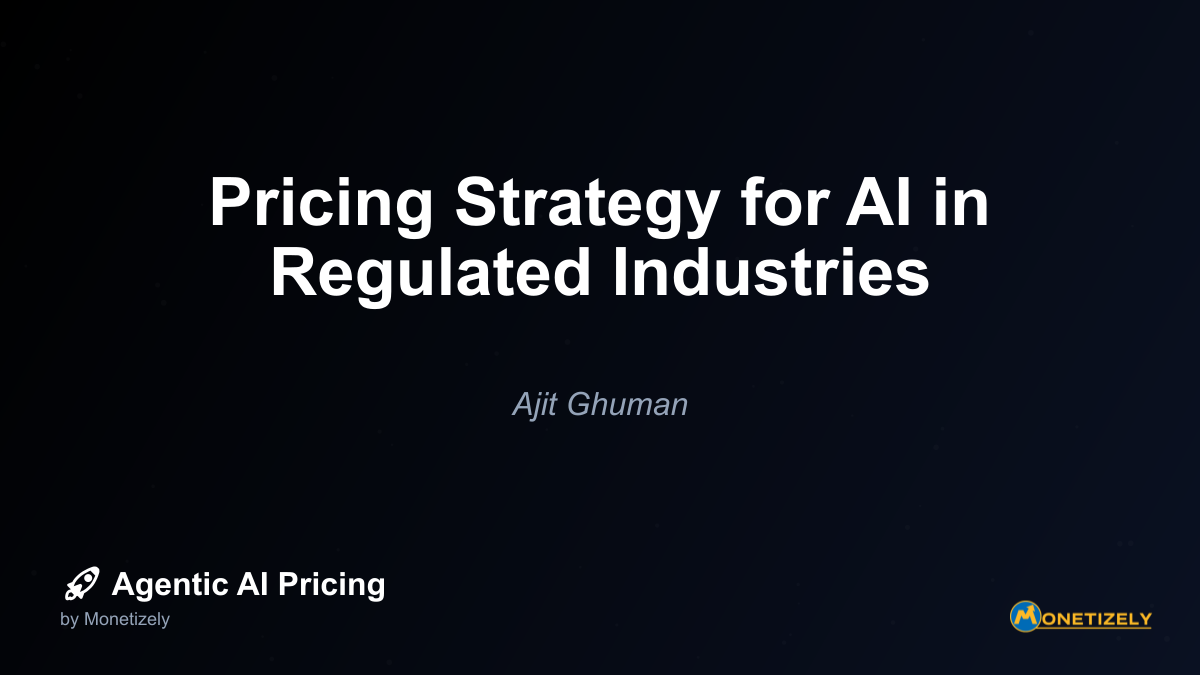· Ajit Ghuman · Industry-Specific · 12 min read
Vertical-Specific Pricing for AI Agents in Government Services
AI and SaaS Pricing Masterclass
Learn the art of strategic pricing directly from industry experts. Our comprehensive course provides frameworks and methodologies for optimizing your pricing strategy in the evolving AI landscape. Earn a professional certification that can be imported directly to your LinkedIn profile.
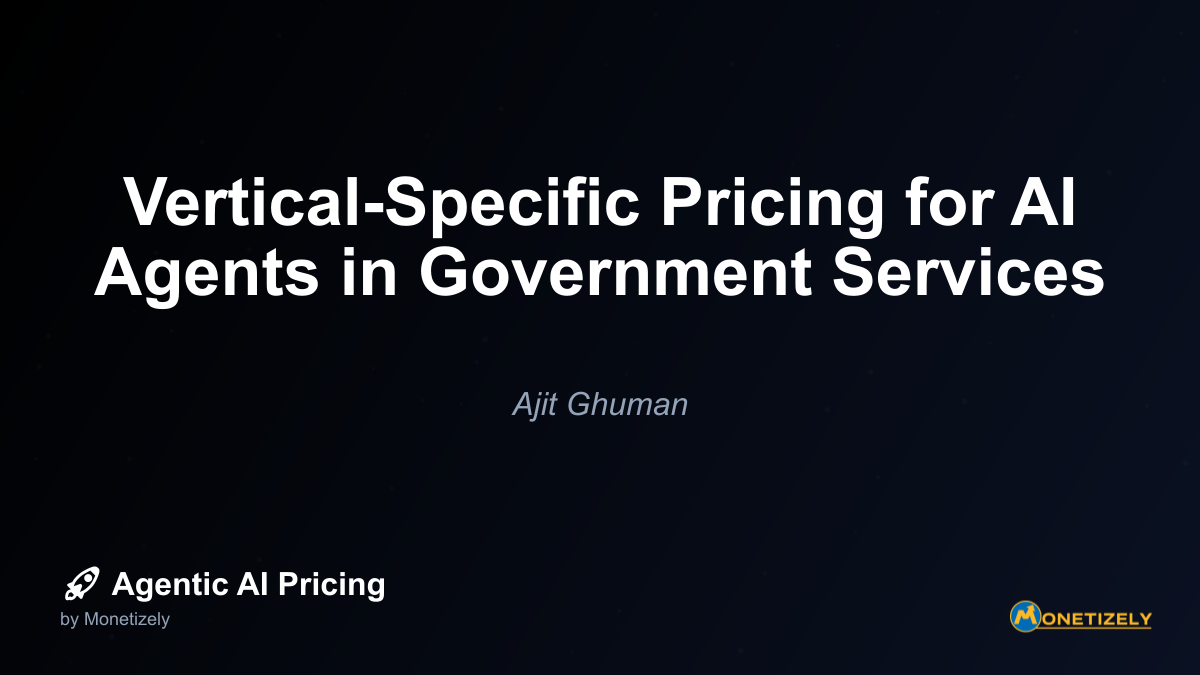
In the rapidly evolving landscape of artificial intelligence, government agencies face unique challenges when implementing and pricing AI agents. The public sector operates under different constraints and considerations than private enterprises, requiring specialized approaches to pricing strategies, procurement processes, and value assessment. This comprehensive analysis examines the vertical-specific pricing considerations for AI agents in government services, providing actionable insights for decision-makers navigating this complex terrain.
The Government AI Landscape: Current State and Challenges
Government adoption of AI technologies continues to accelerate, driven by demands for improved efficiency, better citizen services, and data-driven decision-making. However, the public sector faces distinct challenges that impact how AI agents are priced and procured.
Legacy System Integration Challenges
One of the most significant barriers to AI adoption in government is the prevalence of legacy systems. These decades-old infrastructures were not designed with AI integration in mind, creating technical hurdles that directly impact pricing considerations:
Data Quality and Governance Issues: Government agencies often struggle with siloed, inconsistent data spread across disparate systems, necessitating additional data preparation costs that must be factored into AI pricing models.
Interoperability Requirements: AI solutions must seamlessly connect with existing government systems, increasing implementation complexity and potentially driving up costs.
Technical Debt: The accumulation of outdated technology decisions creates additional burdens when implementing new AI systems, requiring pricing models that account for remediation efforts.
According to recent research, establishing data integrity, improving cyber hygiene, and enhancing legacy system interoperability are foundational requirements before complex AI can be effectively deployed in government settings. These technical challenges directly influence how vendors structure their pricing for government clients.
Procurement Complexity and Budgeting Cycles
Government procurement processes present another layer of complexity for AI pricing strategies:
Extended Procurement Timelines: Government procurement cycles can extend 12-18 months, significantly longer than private sector timelines, requiring pricing models that remain valid throughout extended evaluation periods.
Fiscal Year Budgeting: Annual budget cycles often constrain purchasing decisions, with agencies frequently seeking to allocate funds before fiscal year-end, creating seasonal demand patterns that vendors must accommodate in their pricing strategies.
Multi-Stakeholder Approval Processes: Procurement decisions typically involve numerous stakeholders with different priorities, necessitating pricing models that address varied value metrics across different government functions.
As noted in recent studies, government budgeting and procurement processes are often lengthy and bureaucratic, creating challenges for agile AI adoption. This reality requires vendors to align AI initiatives with multi-year planning while navigating regulatory changes and ensuring adaptability to evolving policies.
Regulatory Framework Impacting AI Pricing in Government
The regulatory environment significantly shapes how AI agents are priced for government applications, with a complex interplay between federal, state, and local requirements.
Federal Regulatory Landscape
At the federal level, recent developments have introduced a “temporary pause” on many state laws regulating AI, particularly those imposing fees or bonds. This pause applies as long as these fees are reasonable, cost-based, and do not discriminate against AI compared to non-AI systems. The federal government has shown reluctance to impose broad pre-emptive restrictions that would fully block state AI regulations, as evidenced by the removal of a proposed 10-year ban on state and local AI regulation in the U.S. Senate.
Key federal considerations impacting AI pricing include:
- Federal Acquisition Regulation (FAR) compliance requirements that vendors must incorporate into their pricing models
- Office of Management and Budget (OMB) guidelines emphasizing data transparency, public trust, and accountability
- National Institute of Standards and Technology (NIST) frameworks for AI risk management that influence implementation costs
State and Local Regulatory Variations
State and local governments are increasingly active in attempting to govern AI, including pricing models embedded in government AI service deployments. States can regulate AI pricing if they do so in a way that is consistent across AI and non-AI systems and do not impose undue burdens on innovation.
Several states are advancing significant legislation that could impact AI governance frameworks:
- New York’s RAISE Act focusing on algorithmic impact assessment
- California’s SB-53 addressing automated decision systems
- Illinois’ AI Video Interview Act regulating AI use in employment contexts
State attorneys general are also signaling enforcement on consumer protection, privacy, and anti-discrimination laws in AI contexts, adding another layer of complexity to pricing considerations.
Value Metrics and ROI Calculation in Government AI
Unlike the private sector’s profit-focused metrics, government success measures are more complex and often activity-oriented, emphasizing cost savings, service delivery improvements, and mission outcomes.
Government-Specific Value Metrics
Government agencies evaluate AI investments through multiple lenses:
- Operational Efficiency: Quantifiable time savings, reduced backlogs, and streamlined workflows
- Service Quality: Improved citizen satisfaction, reduced wait times, and enhanced accessibility
- Mission Effectiveness: Better decision-making, improved outcomes, and enhanced policy implementation
- Public Trust: Transparency, fairness, and accountability in government operations
- Cost Reduction: Direct budget savings and resource optimization
ROI Calculation Approaches
Measuring return on investment for AI in government requires specialized approaches:
- Multi-dimensional Assessment: Combining quantitative metrics (cost reductions, time savings) with qualitative impacts (improved service delivery, transparency)
- Stakeholder Feedback Integration: Incorporating citizen, employee, and leadership perspectives into ROI calculations
- Long-Term Value Projection: Accounting for benefits that may take years to fully materialize
- Risk Mitigation Valuation: Quantifying the value of reduced errors, improved compliance, and enhanced security
Government agencies calculate ROI for AI investments by assessing both tangible and intangible benefits, creating a more holistic picture than purely financial metrics. This approach requires vendors to align their pricing models with these multi-faceted value considerations.
Pricing Models for Different AI Agent Types in Government
Different types of AI agents require specialized pricing approaches based on their functionality, complexity, and value delivery.
Chatbots and Virtual Assistants
Government chatbots typically employ simpler pricing models:
- Per-interaction fees: Charging based on the volume of citizen interactions
- User-based subscriptions: Monthly or annual fees based on the number of citizens served
- Tiered usage plans: Pricing tiers based on interaction volume thresholds
- Fixed annual licensing: Predictable budgeting with unlimited usage
These models align well with the conversational, volume-driven nature of chatbots. For example, a state government might pay $20-30 per user monthly for an AI assistant, potentially scaling by limiting licenses to key departments to manage costs.
Decision Support Systems
Decision support AI requires more sophisticated pricing approaches:
- Tiered autonomy pricing: Higher fees (150-300% premium) for fully autonomous systems compared to semi-autonomous alternatives
- Outcome-based models: Fees linked to measurable improvements in decision quality or efficiency
- Fixed-price contracts: Transferring performance risk to vendors while helping agencies control budgets
- Hybrid models: Combining base subscriptions with performance incentives
These systems command premium pricing due to their direct impact on government decision-making processes and the complexity of their implementation.
Predictive Analytics Tools
Government predictive analytics tools often utilize:
- Data volume pricing: Fees based on the amount of data processed
- API call-based models: Charging per prediction or analysis
- Value-share arrangements: Pricing tied to cost savings or risk reduction achieved
- Department-specific licensing: Tailored pricing for different government functions
These models reflect the computational intensity and specialized nature of predictive analytics in government contexts.
Case Studies: Successful AI Pricing in Government
Several notable implementations demonstrate effective pricing approaches for government AI applications.
Google’s Gemini for Government
Google has pioneered an aggressive pricing strategy for its Gemini for Government platform, offering access at approximately $0.47 to $0.50 per agency annually. This approach demonstrates:
- Ultra-low flat-fee pricing: Making AI broadly accessible across government functions
- Enterprise-wide access: Eliminating internal barriers to adoption
- Security-compliant implementation: Meeting stringent government requirements without premium pricing
This model has proven successful in driving federal agency adoption while maintaining strict security and compliance standards.
AI-Powered Pricing Recommendation Engines
Some government agencies have implemented AI-driven pricing recommendation engines to optimize their own service pricing:
- Dynamic monitoring: Continuously analyzing market conditions and citizen needs
- Competitive benchmarking: Ensuring government fees remain appropriate
- Transparency enhancement: Improving citizen understanding of fee structures
While specific cost details are not publicly disclosed, this approach reduces manual overhead and enhances pricing competitiveness for government services.
Generative AI in Procurement
Several government agencies have successfully deployed generative AI to assist procurement officers:
- Contract screening: Automating initial vendor proposal evaluation
- Vendor performance analysis: Assessing historical performance data
- Statement of work drafting: Generating precise requirements documentation
These implementations often use fixed-price contracting models that reduce financial risks while improving budget adherence.
Budget Constraints and Funding Mechanisms
Government AI implementations operate within unique budgetary frameworks that influence pricing strategies.
Funding Sources for Government AI
AI projects in government are typically funded through:
- Digital Transformation Budgets: Dedicated modernization funds for technology upgrades
- Agency-Specific Operational Budgets: Departmental funds allocated to process improvement
- Federal Grants and Programs: Specialized funding for innovation initiatives
- Public-Private Partnerships: Collaborative funding arrangements with private sector entities
- Technology Modernization Fund (TMF): Federal resources specifically for IT modernization
Vendors must align their pricing strategies with these funding sources, often timing proposals to coincide with budget cycles or grant availability.
Budget Constraints by Government Level
Different levels of government face varying budget constraints:
| Government Level | Budget Characteristics | Pricing Strategy Implications |
|---|---|---|
| Federal | Larger budgets with strict procurement rules | Enterprise agreements; firm-fixed-price contracts; strategic partnerships |
| State | Moderate budgets with variance across departments | Prioritized licensing; multi-agency purchasing arrangements; grant utilization |
| Local | Limited budgets with tight constraints | Minimal seat licensing; pilot projects; shared service arrangements |
These constraints require vendors to tailor their pricing approaches to the specific financial realities of different government entities.
Security and Compliance Requirements
Government AI implementations face stringent security and compliance requirements that impact pricing considerations.
Security Requirements Impacting Pricing
Key security factors influencing AI pricing include:
- FedRAMP Compliance: Meeting federal cloud security standards adds significant implementation costs
- Authority to Operate (ATO): Obtaining necessary security clearances extends implementation timelines
- Data Sovereignty: Requirements for data to remain within specific jurisdictions may increase infrastructure costs
- Continuous Monitoring: Ongoing security assessment requirements add operational expenses
- Personnel Security Clearances: Staff requirements for handling sensitive government data
These requirements often necessitate premium pricing compared to commercial implementations, with vendors needing to amortize compliance costs across their government client base.
Data Privacy Considerations
Privacy requirements add another layer of complexity:
- Privacy Impact Assessments: Mandatory evaluations of AI systems’ privacy implications
- De-identification Requirements: Technical measures to protect personal information
- Consent Management: Systems for managing citizen data usage permissions
- Data Retention Policies: Compliance with government-specific data storage timelines
- Privacy by Design: Architectural requirements that may increase development costs
These considerations directly impact implementation complexity and ongoing operational costs, influencing how vendors structure their pricing models.
International Government AI Pricing Approaches
Approaches to AI pricing vary significantly across international governments, offering valuable comparative insights.
European Union Approaches
EU governments often emphasize:
- Value-based pricing models: Focusing on measurable outcomes rather than technology inputs
- Risk-sharing arrangements: Distributing implementation risk between vendors and agencies
- Transparency requirements: Mandating clear pricing structures without hidden costs
- SME participation incentives: Pricing advantages for smaller vendors to promote innovation
These approaches reflect the EU’s broader emphasis on trustworthy AI and competitive markets.
Asia-Pacific Models
Governments in the Asia-Pacific region frequently utilize:
- Outcome-based contracting: Tying vendor compensation to achieved results
- Public-private partnerships: Collaborative funding and risk-sharing arrangements
- Innovation-focused procurement: Prioritizing cutting-edge solutions over lowest cost
- Capability development pricing: Including knowledge transfer and capacity building in contracts
These models often emphasize long-term relationship building and technology transfer alongside immediate implementation needs.
Comparative Analysis: US vs. International Approaches
Key differences between US and international approaches include:
| Aspect | US Approach | International Approach |
|---|---|---|
| Pricing Transparency | Emphasis on competitive, transparent pricing | Greater flexibility in negotiated arrangements |
| Contract Structure | Often fixed-price or per-user | More outcome-based and value-sharing |
| Risk Allocation | Tends to transfer risk to vendors | More balanced risk-sharing arrangements |
| Innovation Incentives | Technology-focused evaluation | Greater emphasis on outcomes and capabilities |
These differences reflect varying procurement cultures, regulatory environments, and approaches to public sector modernization.
Innovative Pricing Models for Government AI
Several innovative pricing approaches have emerged that address the unique needs of government AI implementations.
Outcome-Based Pricing
This model ties vendor compensation directly to achieved results:
- Benefits: Aligns vendor incentives with government goals; reduces upfront investment risk
- Challenges: Requires clear, measurable outcomes; may face procurement policy limitations
- Implementation: Often structured with base payments plus performance incentives
Outcome-based pricing has shown improved satisfaction and ROI in government AI implementations, particularly for projects with clearly defined success metrics.
Capacity and Autonomy Tiering
This approach adjusts pricing based on the AI system’s autonomy level:
- Benefits: Allows agencies to start with lower-cost supervised systems and upgrade as needed
- Challenges: Requires clear definitions of autonomy levels; may create upgrade friction
- Implementation: Typically structures pricing with significant premiums (150-300%) for fully autonomous capabilities
This model recognizes the varying complexity and value of different autonomy levels, allowing agencies to match capabilities to specific needs and budgets.
Hybrid Models
Combining multiple pricing elements creates flexible approaches:
- Benefits: Balances predictability with performance incentives; adaptable to various use cases
- Challenges: May create complex contracts; requires sophisticated value assessment
- Implementation: Often combines base subscriptions with usage-based or performance components
Hybrid models are particularly effective for interactive or citizen-facing AI like chatbots, blending predictability with incentives for performance.
Resource Allocation Pricing
This approach bases pricing on computational or infrastructure resources:
- Benefits: Directly ties costs to technical requirements; scales with actual usage
- Challenges: May be difficult to budget for; requires monitoring capabilities
- Implementation: Often includes usage caps to control costs while allowing flexibility
Resource allocation pricing is especially relevant for large-scale predictive analytics or decision support systems with variable computational demands.
Future Trends in Government AI Pricing (2025-2027)
Looking ahead, several key trends will shape government AI pricing strategies in the coming years.
Regulatory Harmonization
The tension between federal oversight and state-level experimentation will likely evolve toward greater harmonization:
- Federal legislation may establish baseline standards while allowing state innovation
- Uniform procurement guidelines could emerge to streamline AI acquisition
- Cross-jurisdictional cooperation may facilitate shared services and pricing models
This harmonization could reduce compliance complexity and enable more consistent pricing approaches across government levels.
Value-Based Procurement Evolution
Government procurement will increasingly emphasize outcomes over inputs:
- Performance-based contracting will become more sophisticated
- Citizen impact metrics will gain prominence in procurement decisions
- Total value assessment methodologies will evolve to capture broader benefits
This evolution will favor pricing models that align vendor success with government objectives rather than technology inputs alone.
AI Marketplace Development
Specialized AI marketplaces for government applications will emerge:
- Pre-approved vendor pools will streamline procurement
- Standardized pricing models will facilitate comparison shopping
- Usage-based marketplace pricing will enable flexible consumption
These marketplaces will create more transparent, competitive pricing environments while reducing procurement friction.
Ethical AI Premium
Ethical considerations will increasingly factor into pricing:
- Fairness certifications may command premium pricing
- Transparency capabilities will become value differentiators
- Bias mitigation features will justify higher price points
As government agencies face growing scrutiny around AI ethics, vendors offering robust ethical safeguards may command premium pricing for these capabilities.
Strategic Recommendations for Stakeholders
Based on this comprehensive analysis, several strategic recommendations emerge for both government procurement officials and AI vendors.
For Government Procurement Officials
Develop Multi-Dimensional Value Frameworks: Create comprehensive ROI models that capture both quantitative and qualitative benefits of AI implementations.
Explore Innovative Contracting Vehicles: Leverage flexible procurement methods like Other Transaction Authority (OTA) to enable outcome-based pricing models.
Implement Phased Adoption Strategies: Start with pilot projects using limited licensing before expanding to enterprise-wide implementations.
Establish Cross-Agency Purchasing Coalitions: Combine purchasing power across departments or jurisdictions to negotiate more favorable pricing.
Invest in AI Procurement Expertise: Develop specialized knowledge within procurement teams to effectively evaluate AI pricing models.
For AI Vendors Serving Government
Align Pricing with Budget Cycles: Structure proposals to coincide with government fiscal years and funding availability.
Develop Government-Specific ROI Models: Create value calculators that address the unique metrics relevant to public sector clients.
Offer Flexible Scaling Options: Provide pathways from departmental pilots to enterprise-wide deployment with appropriate pricing tiers.
**Build Compliance Costs into Pricing
Co-Founder & CEO
Ajit is the author of Price To Scale, a top book on SaaS Pricing and is the Founder of Monetizely. Ajit has led and worked in pricing and product marketing at firms like Twilio, Narvar and Medallia. His work has been featured in Forbes and VentureBeat. Ajit regularly consults with software companies from Seed stage to post-IPO on pricing strategy. Ajit is also a highly-rated co-instructor for 'The Art of SaaS Pricing and Monetization' on Maven.
Pricing Strategy Audit
Let our experts analyze your current pricing strategy and identify opportunities for improvement. Our data-driven assessment will help you unlock untapped revenue potential and optimize your AI pricing approach.

